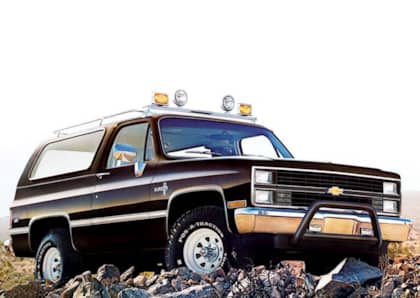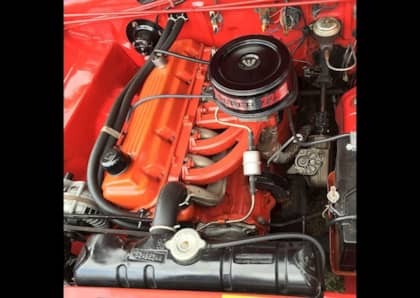The Chevrolet S10 Blazer and GMC S15 Jimmy Delivered Small and Cheap 4X4 SUV Fun
In the early 1980s General Motors was forced to take a long, hard look at its truck and SUV line-up. With fuel efficiency now a watchword for almost every American buyer, the General finally got serious about its compact pickup program, replacing the imported Chevy LUV truck with a home-grown model called the S10 in 1982. Smaller and more frugal than the full-size C/K series, the Chevrolet S10 became the natural launching point for a half-size version of the brand's popular Blazer the following year.

The Chevrolet S10 Blazer (and its GMC S15 Jimmy sibling) were pioneers in the small SUV segment, pre-dating both the Jeep Cherokee and the Ford Bronco II. They helped establish a popular and strong-selling template for entry-level sport-utility vehicles that would dominate the next decade and a half, outlasting its full-size sibling and winning the loyalties of a new set of buyers who might have never previously considered owning a truck.
Just Add Seats
The S10 Blazer/S15 Jimmy formula was a simple one: take the same ladder frame platform used by the Chevrolet S10 and GMC S15 pickups, add a second row of seats, and preserve the same general two-door styling that had worked well for the trucks.

Indeed, from the B-pillar forward the Blazer and Jimmy were identical to their pickup compadres, which made them inexpensive for GM to build. There was no real visual difference between Chevrolet and GMC models aside from grilles and badging.

It was a template very similar to the one used for the full-size Blazer and Jimmy, with a few key differences. Aside from its size (checking in at more than a foot shorter and more narrow than its progenitors), the most important styling decision was the lack of a removable top. Instead, the SUVs featured a full steel roof that offered better protection from the heat and the cold, as well as during a rollover.
Four And Six Cylinders
Drivetrain-wise, the S10 Blazer and S15 Jimmy also steered clear of the V8s that powered GM's full-size SUVs. A base four-cylinder engine (2.0L everywhere but California, where a 1.9-liter mill stood in) was common, but a more popular 2.8L V6 delivered 110hp and made for a better match for the truck's weight. A meager Isuzu-sourced diesel engine could also be specified.

Transmission choices included a five-speed manual or a four-speed automatic, and part-time four-wheel drive was available as an option.

A few years after launch, the Iron Duke 2.5L four-cylinder engine would take its place as the entry-level engine, and by 1988 the venerable 4.3L V6 was made available.

Each of these engines significantly improved the reliability and power of the two SUVs, pushing them past their Ford competition and better matching the H.O. version of the Cherokee in terms of acceleration and hauling.
Four Doors And Turbos
A major update for the Blazer and the Jimmy took place for the 1991 model year when an extra set of doors became available for the first time.

It was a move that would split the difference between the runabout styling and character of the two-door S10 Blazer and S15 Jimmy and the more practical four-door models like the larger version of the Jeep Cherokee and the new (and slightly larger) Ford Explorer.

General Motors would continue to upgrade equipment and features offered by the pair of sport-utilities over the course of the next several years. This included boosting output to either 190 or 200hp (depending on model year) by moving the 4.3L V6 to the Vortec fuel injection system in 1992.

That same year, the Jimmy would lose the 'S15' badge, and also introduce an ultra-quick turbocharged V6 model dubbed the 'Typhoon.' Outfitted with all-wheel drive, the Typhoon was incredibly quick in a straight line, and would enjoy limited production for only a handful of model years.
New Look
By 1995 the Blazer and the Jimmy had followed their respective pickup cousins onto a redesigned platform (with the Chevrolet finally losing its S10 prefix). Their design remained in lock-step, but with considerably more curves and a funky new diagonal C-pillar slashing through the rear glass on two-door models.

The cabin also received a make-over, coming across as more comfortable (although still the height of GM's plastic period) than the more spartan original models. Three years later there would be another mild refresh made to the look of the SUVs, but the general shape would remain the same.

Also big was the death of the four-cylinder model, which made the excellent 4.3 V6 the only available engine for all Blazer and Jimmy trim levels. Their respective drivetrains would continue to become more sophisticated with time, moving to an electronic transfer case in 1998 that could automatically engage the front axle if wheel spin was detected.

A special off-road version of the two-door Blazer, the ZR2, also appeared mid-decade. It added 31 inch tires, more hardcore axle gearing and bearings, Bilstein shocks, and a near 4-inch track boost to go with 3 additional inches of suspension lift.

If street fun was more your thing, by the early 2000s an 'Xtreme' version of the Blazer featuring a full body kit and a lowered ride height had found its way into dealerships.
Sunset For A Popular Duo
By 2005, the small Blazer and its Jimmy twin had run their course. Truck-based SUVs were on their way out and in their place sprung up a host of unibody designs that drew more from the passenger car side of the equation when it came to handling, efficiency, and smoothness.

Although the Chevrolet and GMC sport-utilities managed to outlast the Cherokee and even the truck-platform version of the Explorer (which transitioned to its own unique chassis in 2002), their design was too old school to hack it in an increasingly competitive segment.

It's hard to argue, however, that these SUVs were anything other than a resounding success. For many, GM's twins were their first introduction to the idea that a small truck could be comfortable enough to drive on a daily basis yet still practical when it came to hauling and rugged enough to handle occasional off-road chores. Their longevity on the market also proved that people still wanted to buy a small Blazer even in the midst of the crossover revolution. If General Motors hadn't blundered the transition from Blazer to the larger (and less lauded) Trailblazer, it's possible that we'd still have at least some flavor of small 4x4 on tap from Chevrolet today.
More From Driving Line
- Want to learn more about the ultra-popular 4.3L V6 that powered the Blazer and Jimmy? Here's our deep dive into the history of that engine.











